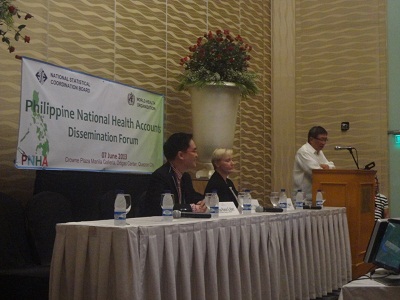
NSCB Secretary General Jose Ramon G. Albert, WHO Representative Dr. Julie Hall and DOH Secretary Enrique Ona lead the forum to release the 2011 Philippine National Health Accounts, 7 July 2013.
The World Health Organization (WHO), in collaboration with the National Statistical Coordination Board (NSCB) has conducted the 2011 Philippine National Health Accounts (PNHA) Dissemination Forum last June 7, 2013 at the Crowne Plaza Manila Galleria, Quezon City. The well-attended forum provided a venue for the presentation of the latest health accounts estimates and brought together producers and users of national health accounts, and other stakeholders including officials and representatives of government and non-government agencies, academe, private sector, international organizations, and the media.
Dr. Jose Ramon G. Albert, NSCB Secretary General, welcomed all participants who showed support and interest by citing the importance of health accounts in policy-making and as a tool for monitoring and tracking outcomes of health sectors policies.
Health Secretary Enrique T. Ona, in his message, described the current status of the country’s health system. The Secretary also expressed his appreciation to the efforts of the NSCB in producing such a very informative and useful health accounts throughout the years, and even challenged for a 6-month interval PNHA report.
Ms. Jessamyn O. Encarnacion, Director of the Social Statistics Office, NSCB, presented the 2011 PNHA. It was reported that the country’s total health expenditure showed improvements between 2009 and 2011, increasing by 12.2% - from PhP 342 billion to PhP 431 billion, respectively. On a per capita basis, spending on health was registered at PhP 4,577 in 2011 – an 11.3% increase from 2010’s PhP 4,112. The national government health spending grew by 22.3%, posting the largest increase in 2011, while local government grew by 9.2%. Other notable results of the 2011 PNHA are as follows:
- Interestingly, for every PhP 100 spent on health goods and services, PhP 63 came from private sources, PhP 27 from the government, PhP 9 from social insurance and PhP 1 from the rest of the world.
- Out of the PhP 63 contribution of private sources, PhP 53 was spent by households and the remaining PhP 10 was spent by other private sources such as private insurance, HMOs, private schools and private establishments.
- Based on the goals set in the National Objectives for Health 2005-2010 of the Department of Health (DOH), only the total health expenditure as percentage of Gross National Income and the per capita health expenditure were within the target.
Dir. Encarnacion also reported that only the Under-five Mortality rate and proportion of tuberculosis cases cured under directly observed treatment short course (DOTS) are among the selected MDG indicators with the highest probability of attainment. She also emphasized that among low-income groups, with most incomes being spent of food - expenditures on health (and education) suffer. To conclude her presentation, Dir. Encarnacion challenges policymakers to strengthen statistical capacity, to continue to use statistics in a greater venue and to achieve targets.
Dr. Lilibeth C. David and Vice-President Ruben John A. Basa pointed out the relevance and use of the PNHA from the perspective of DOH and Philhealth, respectively. National Health Accounts is being used as a basis for budgetary decision-making. As a matter of fact, according to Dr. David, DOH budget has been increasing over the years, and it is projected to increase to as high as PhP89.7 million by 2014 – a 78.0% increase from 2013. Dr. David also declared that the PNHA has been a basis/advocacy for driving health financing and health reforms. PNHA has also triggered the implementation of Local Health Accounts, 2010-2020 Health Care Financing Strategy Monograph, 2011-2016 National Objectives for Health and Philippine Development Plan, and Universal Health Care (Kalusugan Pangkalahatan) Issuances, including Sin Tax Law.
Likewise, Mr. Basa reported that there was an increase in PhilHealth’s membership and benefit payments. Indeed, the National Health Insurance Program (NHIP) is among the fastest growing sectors in terms of health expenditure, registering an average growth rate of 12.5% from 2005 to 2011. However, despite the increasing membership and benefit payments, out-of-pocket spending still account for more than half of the total health expenditure. With this dilemma, PhilHealth is doing its full potential to widen its coverage in terms of membership and available services – true to its vision “Bawat Pilipino, miyembro. Bawat miyembro, protektado. Kalusugan natin, segurado”
Prof. Rachel H. Racelis of UP School of Urban and Regional Planning and Ms. Arlene S. Ruiz of the National Economic and Development Authority mutually pointed out that while the PNHA has been very useful in health policy-making for 20 years now, its usefulness could be further improved by including additional details/categories especially on the uses of health expenditures (i.e. by age group, by disease type, by income group, by location). Prof. Racelis also suggested that improvements on the PNHA’s timeliness and international comparability could be achieved by shifting the present estimation framework to System of Health Accounts 2011 (SHA 2011). In addition, Ms. Ruiz suggested the provision of local-level dimension.
Dr. Julie Hall, WHO Representative in the Philippines, concluded the forum by thanking everyone in their participation to the dissemination forum, and also reiterated the importance of further improvements in disaggregation into a more detailed health accounting. Verily, Dr. Hall expressed WHO’s willingness to provide additional support to work on these issues.
